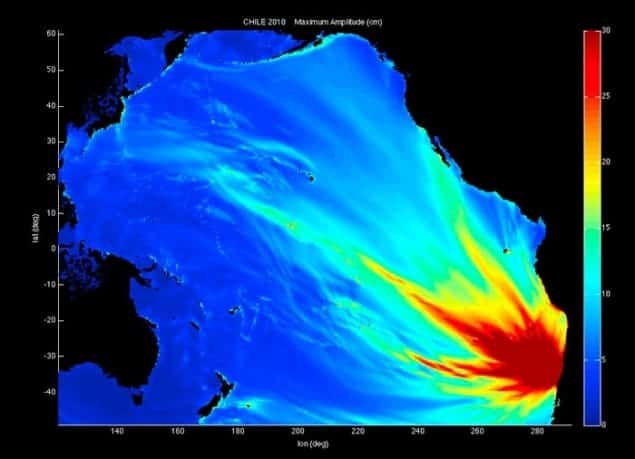
Magnetic anomalies created by tsunamis could be detected by satellites. That’s the claim of researchers in China, who have created a model that simulates the effect of huge ocean waves on the Earth’s magnetic field. The team believes that its work could lead to an early-warning system that can detect the deadly waves in real time.
Tsunamis are huge ocean waves often associated with earthquakes. While they can be tens of metres high when they reach land – often with devastating effects – they tend to have amplitudes of a metre or so in the open ocean. As a result it can be difficult to spot a tsunami against a background of normal waves.
While a tsunami in the open ocean might not be tall it is extremely long and fast moving and therefore involves the rapid displacement of large amounts of water. When a body of salt water moves through the Earth’s magnetic field its conductive nature induces a small anomaly in the field, which can be with a magnetic sensor mounted on a low-Earth-orbit satellite or high-altitude balloon.
Real and model tsunamis
Now, Benlong Wang and colleagues at Shanghai Jiao Tong University have developed a way to predict the local changes in the Earth’s magnetic field caused by a variety of model tsunamis. The basic models can then be combined to simulate the magnetic behaviour of a real-life tsunami. To test these models, the team compared its predictions with data recorded during the 2004 Sumatra and 2010 Chile tsunamis. The team was able to spot magnetic anomalies associated with the events and then estimate the wavelength and height of the tsunami waves.
In principle, a calculation of the tsunami wave profile from a magnetic signal can be done almost instantaneously, Wang told physicsworld.com. If applied in practice this could result in a marked improvement in tsunami early-warning systems. Today’s seismic detection methods, for example, can often take about six minutes to process. A further limitation of seismic prediction and alternative methods based on tidal gauges is that they cannot do continuous tracking of the wave as it moves in the open ocean – whereas magnetic monitoring could be capable of achieving this.
While the technology to detect these magnetic anomalies exists, a suitable infrastructure will need to be developed to provide a comprehensive early-warning network. There are two possible approaches to this, the team explains: using unmanned near-space airships or low-Earth-orbit satellites – both of which are close enough to the ocean to detect the magnetic signal of the wave.
Detection could be problematic
In practice, however, detecting the tsunamis may be more problematic than the researchers claim. “The tsunami magnetic signals are typically about 1–2 nT – compare this with about 40,000 nT of ambient geomagnetic fields,” says Manoj Nair, a geomagnetism expert at the University of Colorado, who was not involved in this study. Nair suggests that, while the researchers may have succeeded in detecting the tsunami signals retrospectively on the magnetic records, real-time detection comes with new challenges: “This is because the time variations in the geomagnetic field from other sources can overwhelm the weak tsunami magnetic signals. I am more sceptical on the use of satellites since [they see] a mix of time and space signals, further complicating the separation of tsunami signals from other sources.”
Nevertheless, Wang and colleagues will continue to test their model against other historical tsunami data. “The next step of our work will focus on the realistic tsunami wave history at Easter Island,” Wang explains. Located in the South Pacific, the island was struck by the 2010 Chile tsunami. The team will use magnetic data gathered from this region in conjunction with global tsunami propagation models to further its understanding of the connection between magnetic anomalies and the sea-surface variations.
The group also plans to look at the magnetic effects of internal waves and tides – movements of water that occur beneath the surface of the ocean and are important in heat and material exchanges between different ocean layers. “Using magnetic signals,” Wang adds, “we expect that these internal flows can be observed conveniently.”
The work is described in Proceedings of the Royal Society A.



